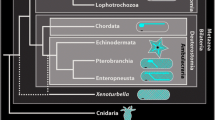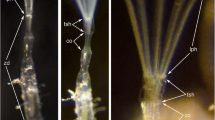Summary
Diffuse and synaptic nerve nets are present in the coenenchymal mesoglea and ectoderm of Muricea and Lophogorgia colonies. The nerve nets extend into the polyp column and tentacles maintaining a subectodermalmesogleal position. The density of nerve elements is low in comparison with similar nerve nets found in pennatulids.
In the column of the polyp anthocodium, and throughout the oral disk region, neurons cross the mesoglea and enter the polyp endoderm. These neurons presumably connect with the endodermal nerve net which innervates the septal musculature. The trans-mesogleal neurons probably represent the connection between colonial and polyp nervous systems.
In the tentacles, longitudinal ectodermal musculature is present with an overlying nerve plexus. These muscles and nerves, as well as tentacular sensory cells, are well represented in the oral side of the tentacles only.
Presumed sensory cells form ciliary cone complexes in which one cell possesses an apical cilium. The other cells as well as the centrally located nematocyte contribute microvilli to the cone. The basal portion of the sensory cells is drawn into one or more neurite-like processes which enter the ectodermal nerve plexus. Similar processes form synapses with longitudinal muscle cells and nematocytes. The sensory cells of the ciliary cones presumably include chemoreceptors which can activate or modify nematocyst discharge, local muscle twitches, and tentacle bending.
Similar content being viewed by others
References
Anderson, P.A.V.: The electrophysiology of the organ-pipe coral Tubipora musica. Biol. Bull. 150, 337–347 (1976a)
Anderson, P.A.V.: An electrophysiological analysis of behavioral integration in colonial anthozoans. In: Coelenterate ecology and behavior (G.O. Mackie, ed.), pp. 609–618. Plenum Press 1976b
Anderson, P.A.V., Case, J.F.: Electrical activity associated with luminescence and other colonial behavior in the pennatulid Renilla kollikeri. Biol. Bull. 149, 80–95 (1975)
Andres, K.H.: Anatomy and ultrastructure of the olfactory bulb in fish, amphibia, reptiles, birds and mammals. In: (G.E.W. Wolstenholme and J. Knight, eds.) Taste and smell in vertebrates, pp. 177–194. J. & A. Churchill 1970
Ashworth, J.H.: The structure of Xenia hicksoni, with some observations on Heteroxenia elizabethae Kölliker. Quart. J. micr. Sci. 42, 245–304 (1899)
Batham, E.J.: The neural architecture of the sea anemone Mimetridium cryptum. Amer. Zool. 5, 395–402 (1965)
Batham, E.J., Pantin, C.F.A., Robson, E A.: The nerve-net of Metridium senile: Artifacts and the nervenet. Quart. J. micr. Sci. 102, 143–156 (1961)
Bilbaut, A., Pavans de Ceccatty, M.: Les différenciations cellulaires chez l'Octocoralliaire Veretillum cynomorium Pall. C.R. Acad. Sci. (Paris) 272, 3053–3056 (1971a)
Bilbaut, A., Pavans de Ceccatty, M.: Les récepteurs de l'Octocoralliaire Veretillum cynomorium Pall. C.R. Acad. Sci (Paris) 272, 3150–3153 (1971b)
Buisson, B.: Les supports morphologiques de l'intégration dans la colonie de Veretillum cynomorium Pall. (Cnidaria, Pennatularia) Z. Morph. Tiere 68, 1–36 (1970)
Buisson, B., Franc, S.: Structure et ultrastructure des cellules mésenchymateuses et nerveuses intramésogléenes de Veretillum cynomorium Pall. (Cnidaria, Pennatularia). Vie Milieu 20, 279–292 (1969)
Conklin, E.J., Mariscal, R.N.: Increase in nematocyst and spirocyst discharge in a sea anemone in response to mechanical stimulation. In: Coelenterate ecology and behavior (G.O. Mackie, ed.), pp. 549–558. New York: Plenum Press 1976
Davenport, D., Ross, D.M.: Sutton, L.: The remote control of nematocyst-discharge in the attachment of Calliactis parasitica to shells of hermit crabs. Vie Milieu 12, 197–209 (1961)
Dietrich, H.F., Fontaine, A.R.: A decalcification method for ultrastructure of echinoderm tissues. Stain Technol. 50, 351–354 (1975)
Ellis, V.L., Ross, D.M. Sutton, L.: The pedal disc of the swimming sea anemone Stomphia coccinea during detachment, swimming, and resettlement. Canad. J. Zool. 47, 333–342 (1969)
Gabe, M.: Techniques histologiques. Paris: Masson 1968
Gohar, H.A.F, Roushdy, H.M.: The neuromuscular system of the Xeniidae (Alcyonaria) I. Histological. Publ. Mar. Biol. Sta., Ghardaqa 10, 63–81 (1959)
Graziadei, P.P.C., Tucker, D.: Vomeronasal receptors in Turtles. Z. Zellforsch. 105, 498–514 (1970)
Hickson, S.J.: The anatomy of Alcyonium digitatum. Quart. J. micr. Sci. 37, 343–388 (1895)
Hyman, L.H.: The invertebrates, Vol. 1. New York: McGraw-Hill 1940
Jackson, A.J., McFarlane, I.D.: Delayed initiation of SSl pulses in the sea anemone Calliactis parasitica: Evidence for a fourth conducting system. J. exp. Biol. 65, 539–552 (1976)
Kawaguti, S.: Electron microscopy on the spicules and the polyp of a gorgonian, Euplexaura erecta. Biol. J. Okayama Univ. 10, 23–38 (1964)
Kawaguti, S.: Electron microscopy on a soft coral, Heteroxenia elisabethae Kölliker. Biol. J. Okayama Univ. 15, 25–35 (1969)
Larsen, J.R.: The use of Holmes' silver stain on insect nerve tissue. Stain Technol. 35, 223–224 (1960)
Leversee, G.J.: Flow and feeding in fan-shaped colonies of the gorgonian coral, Leptogorgia. Biol. Bull. 151, 344–356 (1976)
Lyke, E.B.: The histology of the sea pansies, Renilla reniformis (Pallas) and Renilla köllikeri (Pfeffer) with a note on the fine structure of the latter species. PhD Thesis, University of Wisconsin (1965)
Mariscal, R.N.: Scanning electron microscopy of the sensory surface of the tentacles of sea anemones and corals. Z. Zellforsch. 147, 149–156 (1974)
Mariscal, R.N., Bigger, C.H.: A comparison of putative sensory receptors associated with nematocysts in an anthozoan and a scyphozoan. In: Coelenterate ecology and behavior (G.O. Mackie, ed.) pp. 559–568. New York: Plenum Press 1976
McFarlane, I.D.: Two slow conduction systems in the sea anemone Calliactis parasitica. J. exp. Biol. 51, 377–385 (1969)
Murray, R.G., Murray, A.: The anatomy and ultrastructure of taste endings. In: Taste and smell in vertebrates (G.E.W. Wolstenholme and J. Knight, eds.), pp. 3–25. London: J.A. Churchill 1970
Pantin, C.F.A. The excitation of nematocysts. J. exp. Biol. 19, 294–310 (1942)
Pavans de Ceccatty, M., Buisson, B.: Le systéme nerveux intramésogléen dans les colonies de Veretillum cyomorium (Cnidaria, Pennatulidae) C.R. Acad. Sci. (Paris) 259, 3611–3613 (1964)
Peteya, D.J.: The ciliary-cone sensory cell of anemones and cerianthids. Tissue and Cell 7, 243–252 (1975)
Ross, D.M., Sutton, L.: Inhibition of the swimming response by food and of nematocyst discharge during swimming in the sea anemone Stomphia coccinea. J. exp. Biol. 41, 751–757 (1964)
Satterlie, R.A., Anderson, P.A.V., Case, J.: Morphology and electrophysiology of the throughconducting systems in pennatulid coelenterates. In: Coelenterate ecology and behavior (G.O. Mackie ed.) pp. 619–627. New York: Plenum Press 1976
Shelton, G A.B.: Colonial conduction systems in the Anthozoa: Octocorallia. J. exp. Biol. 62, 571–578 (1975)
Spurlock, B.O., Cormier, M.J.: A fine structure study of the anthocodium in Renilla mülleri. Evidence for the existence of a biolumninescent organelle, the luminelle. J. Cell Biol. 64, 15–28 (1975)
Titschack, H.: Über das Nervensystem der Seefeder Veretillum cynomorium (Pallas). Z. Zellforsch. 90, 347–371 (1968)
Titschack, H.: Über das mesogloeale Nervensystem der Oktokorallen Alcyoniumpalmatum (Pallas) und Eunicella stricta (Bertoloni) Zool. Anz. 185, 68–75 (1970a)
Titschack, H.: Histologische Untersuchung des mesogloealen Nervenplexus der Seefedern Pennatula rubra (Ellis) und Pteroides griseum (Bohadsch). Vie Milieu 21, 95–102 (1970b)
Westfall, J.A.: Nematocysts of the sea anemone Metridium. Amer. Zool. 5, 377–393 (1965)
Westfall, J.A.: Ultrastructure of synapses in a primitive Coelenterate. J. Ultrastruct. Res. 32, 237–246 (1970a)
Westfall, J.A.: The nematocyte complex in a Hydromedusan, Gonionemus vertens. Z. Zellforsch. 110, 457–470 (1970b)
Westfall, J.A., Yamataka, S., Enos, P.D.: Ultrastructural evidence of polarized synapses in the nerve net of Hydra. J. Cell Biol. 51, 318–323 (1971)
Author information
Authors and Affiliations
Additional information
This work was supported by Office of Naval Research Contract N00014-75-C-0242, NSF Grant BMS 74-23242 and General Research Funds of the University of California, Santa Barbara. We wish to thank Dr. Steven K. Fisher for the use of facilities in his lab. This paper is part of a thesis to be submitted by R.A.S. to the Department of Biological Sciences, University of California, Santa Barbara in partial fulfillment of the requirements for the Ph. D.
Rights and permissions
About this article
Cite this article
Satterlie, R.A., Case, J.F. Neurobiology of the gorgonian coelenterates, Murcea californca and Lophogorgia chilensis . Cell Tissue Res. 187, 379–396 (1978). https://doi.org/10.1007/BF00229604
Accepted:
Issue Date:
DOI: https://doi.org/10.1007/BF00229604




